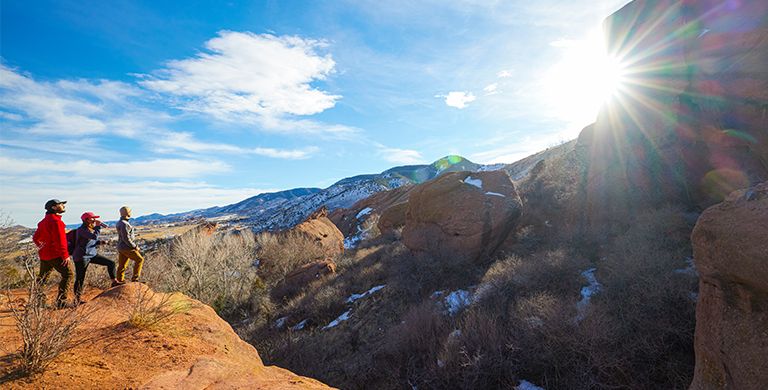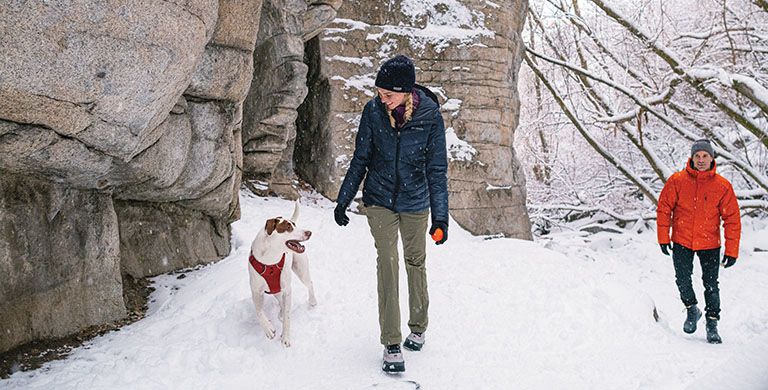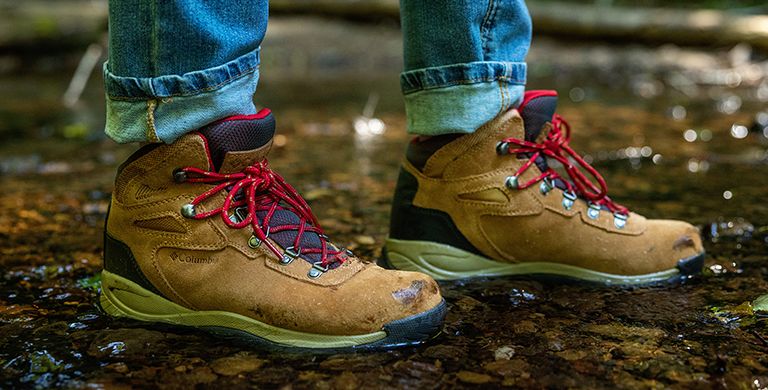HIKING
How to Prevent Chafing on the Trail
From hiking to trail running, here are some tips to keep you chafe-free
BY DAVID YOUNG
It’s a pretty common scenario: you’re a few miles into a hike or trail run when you feel a slight rub that leads to a burn, and before you realize what’s happening, you have chafed skin. It’s a surefire way to ruin a fun day. The good news is that there are ways to prevent chafing on the trail.
To get some anti-chafing tips, we sat down with Moona Page, senior apparel design manager for Columbia Sportswear. A lot of the solution comes down to high-quality hiking gear, she said, which you can use off the trail too.
“If you're somebody who’s prone to chafing when you hike, you're probably also prone to chafing when you walk around the city for long periods of time. Or when you’re traveling, taking urban tours, or even just running errands,” Page said. “That’s why it’s nice to have hiking gear that is technical and performance-based but can also be worn around town.”
Read on to learn what Page had to say about how to stop chafing.
To get some anti-chafing tips, we sat down with Moona Page, senior apparel design manager for Columbia Sportswear. A lot of the solution comes down to high-quality hiking gear, she said, which you can use off the trail too.
“If you're somebody who’s prone to chafing when you hike, you're probably also prone to chafing when you walk around the city for long periods of time. Or when you’re traveling, taking urban tours, or even just running errands,” Page said. “That’s why it’s nice to have hiking gear that is technical and performance-based but can also be worn around town.”
Read on to learn what Page had to say about how to stop chafing.

What causes chafing?
Chafing is caused by the friction of skin rubbing against other skin or material. This is where the term “friction rash” comes from.
The problem is made worse when there is moisture from sweating, combined with ill-fitting clothes and inferior materials that don’t breathe or flex.
Page sums it up easily by saying, “It’s the combination of sweat and friction—skin rubbing together. That can cause anything from irritation to red bumps to blisters. It is very uncomfortable when you're walking or hiking.”
The problem is made worse when there is moisture from sweating, combined with ill-fitting clothes and inferior materials that don’t breathe or flex.
Page sums it up easily by saying, “It’s the combination of sweat and friction—skin rubbing together. That can cause anything from irritation to red bumps to blisters. It is very uncomfortable when you're walking or hiking.”
Why is chafing common for hikers and trail runners?
Hikers and trail runners are constantly moving, often making their legs rub together. If you add sweat and friction heat to the mix, you’ve got the perfect recipe for chafing. While hikers are especially prone to chafing on the legs, it can happen anywhere that friction occurs on the body.
What are the main types of chafing?
There are four main kinds of chafing that hikers and runners experience:
- Thigh chafing
- Underarm chafing
- Waist chafing
- Nipple chafing
Thigh chafing
Thigh chafing is the most common. It is caused by extended periods of walking or running, which can create friction between the inner thighs and result in inflamed, damaged skin. Given that it’s also an area that generates heat and sweat, it is common to see chafing between the legs. It is especially common for women, although men experience it too.
“The number one thing we want to address is between the thighs,” said Page, noting that the type of hiking pants you wear makes a huge difference. “The fabric needs to be tight in those areas that are prone to chafing because if you have loose fabric, it can move, and then you have your thighs or parts of your skin touching together.”
“The number one thing we want to address is between the thighs,” said Page, noting that the type of hiking pants you wear makes a huge difference. “The fabric needs to be tight in those areas that are prone to chafing because if you have loose fabric, it can move, and then you have your thighs or parts of your skin touching together.”
Underarm chafing
While less common than thigh chafing, underarm chafing can occur when you wear sleeveless tops with a backpack. The combination can create uncomfortable friction that results in red, raw skin.
The key to preventing underarm chafing is to pick the right shirt. The best option is a shirt with short or long sleeves so there's no skin making contact with the backpack straps. As a bonus, you get the added sun protection too.
If you do opt for a sleeveless hiking shirt, Page recommends choosing one with a higher armhole to avoid strap-to-skin contact.
It’s also important to make sure that your backpack fits right. If it’s too big or too far away from your body it can pull and drag, making it uncomfortable on your underarms.
The key to preventing underarm chafing is to pick the right shirt. The best option is a shirt with short or long sleeves so there's no skin making contact with the backpack straps. As a bonus, you get the added sun protection too.
If you do opt for a sleeveless hiking shirt, Page recommends choosing one with a higher armhole to avoid strap-to-skin contact.
It’s also important to make sure that your backpack fits right. If it’s too big or too far away from your body it can pull and drag, making it uncomfortable on your underarms.
Chafing at the waist
This type of chafing is most associated with the belt of a backpack, which can rub at your waist and cause friction.
If you’re backpacking with a heavy load that puts pressure on the waist belt, consider opting for hiking pants or leggings without features like buckles, buttons, and zippers—known as “trim features.”
“Choosing hiking pants without any trim features helps prevent zippers from pushing against your skin or other items rubbing and chafing,” Page said. “Especially if you have a heavy backpack and you're hiking for several days, opting for pants that are pull-on styles will help avoid pressure from trim onto your skin.”
This isn’t as important for day hikers, she said, pointing out that if you’re not on an overnight trip, you might not have a waist belt anyway. But for longer adventures, consider leggings or trim-free hiking pants.
If you’re backpacking with a heavy load that puts pressure on the waist belt, consider opting for hiking pants or leggings without features like buckles, buttons, and zippers—known as “trim features.”
“Choosing hiking pants without any trim features helps prevent zippers from pushing against your skin or other items rubbing and chafing,” Page said. “Especially if you have a heavy backpack and you're hiking for several days, opting for pants that are pull-on styles will help avoid pressure from trim onto your skin.”
This isn’t as important for day hikers, she said, pointing out that if you’re not on an overnight trip, you might not have a waist belt anyway. But for longer adventures, consider leggings or trim-free hiking pants.
Nipple chafing
This type of chafing mainly occurs in trail runners and thru-hikers who go long distances at a fairly fast pace. It’s not as common on day hikes or short backpacking trips.
Sports bras often prevent this issue for women; however, men tend to be more susceptible to it because their skin often rubs directly against their shirt as they sweat.
Quality of fabric is important to preventing nipple chafing, Page explained. Some fabrics can have an interior texture, which you want to avoid if you're prone to nipple chafing.
Consider buying garments made of fabric that has a smooth underside or a surface that is almost silky.
Another trick to avoid nipple chafing is to use adhesive bandages or lubricants. Petroleum jelly works fine, and there are also anti-chafe balms on the market designed specifically for runners and hikers.
Sports bras often prevent this issue for women; however, men tend to be more susceptible to it because their skin often rubs directly against their shirt as they sweat.
Quality of fabric is important to preventing nipple chafing, Page explained. Some fabrics can have an interior texture, which you want to avoid if you're prone to nipple chafing.
Consider buying garments made of fabric that has a smooth underside or a surface that is almost silky.
Another trick to avoid nipple chafing is to use adhesive bandages or lubricants. Petroleum jelly works fine, and there are also anti-chafe balms on the market designed specifically for runners and hikers.

What should you wear to prevent chafing?
Since chafing is basically caused by unwanted friction, the clothes you pick will make a significant difference. There are three key qualities you should look for when shopping for anti-chafe hiking and trail clothes.
1. Moisture-wicking material
This is the number one thing to consider, according to Page. Sweat plus movement is a disaster when it comes to chafing. Your hiking clothes need to be able to manage moisture, whether it's coming from sweat or the environment. That’s where technology like Omni-Wick can save the hike.
“You need to avoid moisture being trapped and make sure that it has a way of being released,” Page said. “The quick-drying, the wicking part, is a very important factor. If you're running and sweating, if you go swimming, if you're by a river, if you get into a downpour, if you're stuck in rain, whatever it is between storms, allowing your clothes to dry as fast as possible will help prevent chafing.”
“You need to avoid moisture being trapped and make sure that it has a way of being released,” Page said. “The quick-drying, the wicking part, is a very important factor. If you're running and sweating, if you go swimming, if you're by a river, if you get into a downpour, if you're stuck in rain, whatever it is between storms, allowing your clothes to dry as fast as possible will help prevent chafing.”
2. Compression fabric
The next thing you want is compression fabric. This puts light pressure on your skin, protecting it from friction. “You need to have something with the right type of compression,” Page said, pointing to fabrics with high elastic content and a tight-knit structure.
“The compression fabric that we use at Columbia typically has a higher elastic content. It can range anywhere from 7 to 18%, so that helps a lot with chafing. And then it also has to do with the construction, the knitting of the fabric, which can be loose or thick. You want a tighter construction.”
“The compression fabric that we use at Columbia typically has a higher elastic content. It can range anywhere from 7 to 18%, so that helps a lot with chafing. And then it also has to do with the construction, the knitting of the fabric, which can be loose or thick. You want a tighter construction.”
3. Performance fit
The third point to consider is the fit of your hiking clothes. Page notes that typical hiking pants are either relaxed, active, or performance fits. Leggings are usually performance fit, which makes them a good choice.
“I have learned the hard way to make sure that the fit and the fabric are both right for long hikes because I’ve shortened my hikes before due to chafing,” Page said. “I have been extremely uncomfortable and could not enjoy my time. So I'm very particular about the hiking clothes I wear, and that the fabric can wick away moisture.”
She says the options aren’t limited to just leggings—there are hiking pants that are form-fitting too. They just need to have stretchy material and not be too loose.
In addition to performance-fit pants, she said to look for form-fitting tank tops or sports bras made of compression fabric. Stay away from relaxed fits.
“I have learned the hard way to make sure that the fit and the fabric are both right for long hikes because I’ve shortened my hikes before due to chafing,” Page said. “I have been extremely uncomfortable and could not enjoy my time. So I'm very particular about the hiking clothes I wear, and that the fabric can wick away moisture.”
She says the options aren’t limited to just leggings—there are hiking pants that are form-fitting too. They just need to have stretchy material and not be too loose.
In addition to performance-fit pants, she said to look for form-fitting tank tops or sports bras made of compression fabric. Stay away from relaxed fits.

What else can you put on to prevent chafing?
In addition to wearing high-quality hiking gear, another way to stop your skin from chafing when you’re hiking is with a balm. Just keep in mind that you need to keep reapplying it or it won’t work for the long haul.
“Balms can be helpful, but really, at the end of the day, it's the garment that's going to protect you,” Page said. “Anti-chafe balms do help temporarily, but after a short duration of time, they wear off.”
As far as your feet go, make sure to break in your hiking boots so you don’t get any chafing or blisters there.
Between proper clothing and a little knowledge of what causes chafing, you can avoid annoying friction rashes and get back to what really matters—your hike.
“Balms can be helpful, but really, at the end of the day, it's the garment that's going to protect you,” Page said. “Anti-chafe balms do help temporarily, but after a short duration of time, they wear off.”
As far as your feet go, make sure to break in your hiking boots so you don’t get any chafing or blisters there.
Between proper clothing and a little knowledge of what causes chafing, you can avoid annoying friction rashes and get back to what really matters—your hike.
Ready to hit the trail? Check out our anti-chafing hiking gear.



